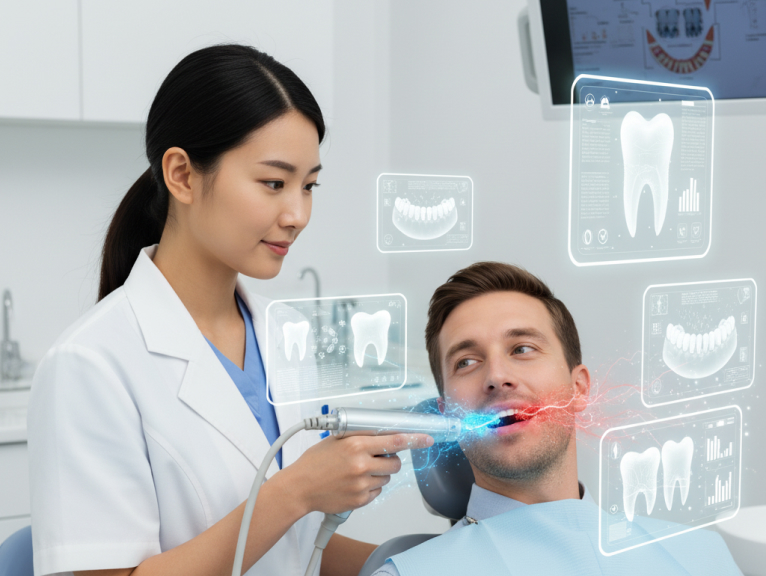
20 Years of Producing the Highest Quality, Most Reliable, and Effective LED mask.
Discover how combining blue and red light therapy can improve oral health by targeting harmful bacteria, reducing inflammation, and promoting gum and bone regeneration. Learn about the mechanisms, clinical studies, and practical applications of this innovative approach.

Oral health plays a vital role in overall well-being. Poor oral hygiene can lead to gum disease, cavities, bad breath, and even contribute to systemic issues like heart disease and diabetes. Ensuring proper oral care is essential, but even with regular brushing and flossing, bacteria can still thrive, leading to various oral health problems.
Incorporating blue and red light therapy into your oral care routine can optimize your dental hygiene, targeting harmful bacteria, reducing inflammation, and promoting gum regeneration. Let’s explore how combining these therapies can significantly enhance oral health.
Blue light therapy operates in the 400–495 nm wavelength and is primarily used for its antimicrobial properties. It is particularly effective at targeting the anaerobic bacteria that cause periodontal diseases and bad breath. Blue light energy is absorbed by the bacteria, producing reactive oxygen species that kill harmful microbes, while leaving beneficial bacteria intact.
Red light therapy works in the 620–700 nm wavelength and penetrates deeper into tissues compared to blue light. It stimulates the mitochondria in cells, promoting ATP production, which in turn accelerates the healing of gum tissues, reduces inflammation, and aids in collagen synthesis—key factors for gum and bone regeneration.
When used together, blue light kills bacteria while red light promotes healing and regeneration, creating a powerful combination for oral health.
Blue light works by targeting the pigmented bacteria in the oral cavity. These bacteria contain porphyrins that absorb the blue light, causing a photochemical reaction that kills the bacteria. This selective action helps reduce plaque, bad breath, and gum disease without harming the beneficial bacteria in your mouth.
Red light therapy enhances the body’s ability to heal by stimulating the mitochondria in cells, leading to increased ATP production. This cellular energy boost accelerates tissue repair, reduces inflammation, and promotes collagen production, essential for gum regeneration and improving overall gum health.
Clinical studies have shown that both blue and red light therapies can significantly improve oral health. For example:
These therapies offer a non-invasive, effective, and safe way to improve oral hygiene and prevent dental issues.
Now that you understand how blue and red light therapy works, let’s dive into how to incorporate it into your oral care routine:
To start using light therapy, you’ll need a device that combines both blue and red light. There are several products on the market designed for home use, such as LED mouthpieces and LED toothbrushes, which emit both blue and red light wavelengths. Here are some common devices:
Make sure the device you choose provides the correct wavelengths for both blue (400-495 nm) and red (620-700 nm) light.
Use light therapy consistently for optimal results. Most people see improvements in gum health and reduced inflammation after 2–3 weeks of regular use. Remember that light therapy should complement your regular oral hygiene routine, including brushing and flossing.
Q1: Is light therapy safe for oral health?
A1: Yes, both blue and red light therapies are considered safe for oral health when used as directed. These therapies are non-invasive and generally have minimal side effects.
Q2: How often should I use light therapy for oral health?
A2: It’s recommended to use light therapy devices 2-3 times per week, depending on the severity of the condition. Regular use will help improve gum health, reduce inflammation, and eliminate harmful bacteria.
Q3: Can light therapy replace traditional oral hygiene practices?
A3: No, light therapy should be used in addition to your regular brushing, flossing, and professional dental care. It helps enhance your oral hygiene routine, but it doesn’t replace it.
Q4: Are there any side effects?
A4: Light therapy is generally safe with very few side effects. Some users may experience mild discomfort or sensitivity during treatment, but these effects are typically temporary.
Incorporating blue and red light therapy into your daily oral health routine can help maintain a healthy mouth and gums by targeting harmful bacteria, reducing inflammation, and promoting tissue regeneration. As more research supports its efficacy, light therapy may become a common tool in both preventive oral care and restorative dental treatments.
For more information on photobiomodulation and its applications in oral health, consider exploring the following resources:
References:
